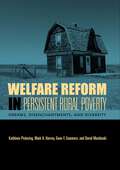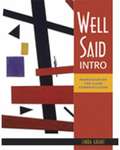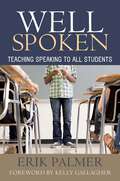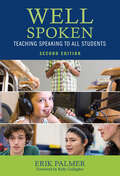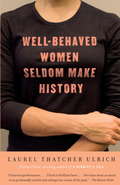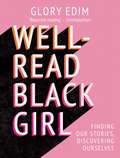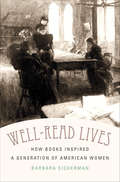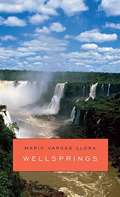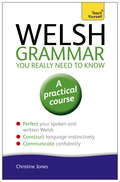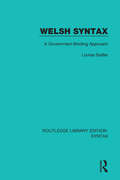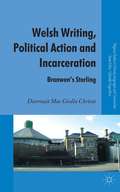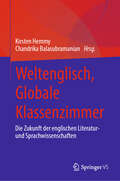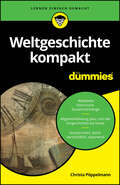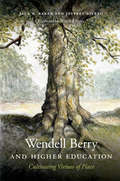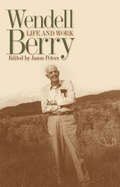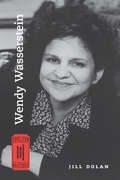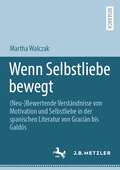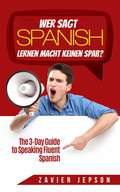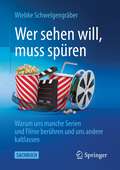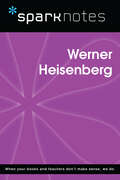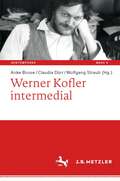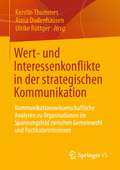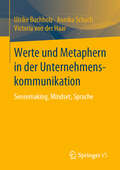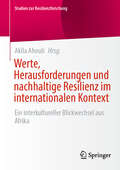- Table View
- List View
Welfare Reform in Persistent Rural Poverty: Dreams, Disenchantments, and Diversity (Rural Studies)
by Kathleen Pickering Mark H. Harvey Gene F. Summers David MushinskiSince the Personal Responsibility and Work Opportunity Reconciliation Act of 1996 was enacted, policy makers, agency administrators, community activists, and academics from a broad range of disciplines have debated and researched the implications of welfare reform in the United States. Most of the attention, however, has focused on urban rather than rural America. Welfare Reform in Persistent Rural Poverty examines welfare participants who live in chronically poor rural areas of the United States where there are few job opportunities and poor systems of education, transportation, and child care. Kathleen Pickering and her colleagues look at welfare reform as it has been experienced in four rural and impoverished regions of the United States: American Indian reservations in South Dakota, the Rio Grande region, Appalachian Kentucky, and the Mississippi Delta. Throughout these areas the rhetoric of reform created expectations of new opportunities to find decent work and receive education and training. In fact, these expectations have largely gone unfulfilled as welfare reform has failed to penetrate poor areas where low-income families remain isolated from the economic and social mainstream of American society. Welfare Reform in Persistent Rural Poverty sheds welcome light on the opportunities and challenges that welfare reform has imposed on low-income families situated in disadvantaged areas. Combining both qualitative and quantitative research, it will be an excellent guide for scholars and practitioners alike seeking to address the problem of poverty in rural America.
Well Said Intro
by Linda GrantOffering a lively and communicative approach for increasing pronunciation and speaking skills, Well Said Intro provides beginning to mid-intermediate students with the pronunciation and speaking tools they need to communicate in social, academic, and professional settings.
Well Spoken: Teaching Speaking to All Students
by Erik PalmerAll teachers at all grade levels in all subjects have speaking assignments for students, but many teachers believe they don't know how to teach speaking, and many even fear public speaking themselves. In his new book, Well Spoken, veteran teacher and education consultant Erik Palmer shares the art of teaching speaking in any classroom. Teachers will find thoughtful and engaging strategies for integrating speaking skills throughout the curriculum. Palmer stresses the essential elements of all effective oral communication, including:, Building a Speech: Audience, Content, Organization, Visual Aids, and Appearance, Performing a Speech: Poise, Voice, Life, Eye Contact, Gestures, and Speed, Evaluating a Speech: Creating Effective Rubrics,' Guiding Students to Excellence Well Spoken contains a framework for understanding the skills involved in all effective oral communication, offers practical steps and lesson ideas that any teacher needs to successfully teach speaking in a variety of situationsfrom classroom discussions to' formal presentationsand includes a set of tools for studentsfrom how to grab the audience's attention to how to use emphatic hand gestures and adjust speed for effect. Discover why, year after year, students returned to Palmer's classroom to thank him for teaching them how to be well spoken. You may find, after reading this book, that you have become a better speaker, too.
Well Spoken: Teaching Speaking to All Students
by Erik PalmerTeachers at all grade levels in all subjects have speaking assignments for students, but many teachers believe they don't know how to teach speaking, and many even fear speaking to groups themselves.In Well Spoken veteran teacher and education consultant Erik Palmer shares the art of teaching speaking in any classroom. Teachers will find thoughtful and engaging strategies, lessons, and tips for integrating speaking skills throughout the curriculum. Palmer stresses the essential elements of all effective oral communication used in one-to-one, small group, large group, formal, informal, in-person, and digital situations including:● Building a Speech: Audience, Content, Organization, Visual Aids, and Appearance● Performing a Speech: Poise, Voice, Life, Eye Contact, Gestures, and Speed● Evaluating a Speech: Creating Effective Rubrics, Guiding Students to ExcellenceIn this updated second edition, Palmer builds on his tried and true framework, with the addition of practical steps and lesson ideas for teaching speaking in a variety of digital contexts. With new chapters focusing on digital speaking contexts including podcasts, webinars, and video/audio apps, Palmer demonstrates how to adjust and enhance the teaching of speaking to include both in-person and digital contexts.Discover why, year after year, students returned to Palmer's classroom to thank him for teaching them how to be well spoken. You may find, after reading this book, that you have become a better speaker, too.
Well-Behaved Women Seldom Make History
by Laurel Thatcher UlrichFrom admired historian-and coiner of one of feminism's most popular slogans-Laurel Thatcher Ulrich comes an exploration of what it means for women to make history. In 1976, in an obscure scholarly article, Ulrich wrote, "Well behaved women seldom make history. " Today these words appear on t-shirts, mugs, bumper stickers, greeting cards, and all sorts of Web sites and blogs. Ulrich explains how that happened and what it means by looking back at women of the past who challenged the way history was written. She ranges from the fifteenth-century writer Christine de Pizan, who wroteThe Book of the City of Ladies,to the twentieth century#x19;s Virginia Woolf, author ofA Room of One's Own. Ulrich updates their attempts to reimagine female possibilities and looks at the women who didn't try to make history but did. And she concludes by showing how the 1970s activists who created "second-wave feminism" also created a renaissance in the study of history.
Well-Read Black Girl: Finding Our Stories, Discovering Ourselves
by Glory Edim'Required reading.' - Cosmopolitan'This should be read as a sacred text. Here, you will bear witness to a perpetual salvation song.' - Jason ReynoldsRemember that moment when you first encountered a character who seemed to be written just for you? That feeling of belonging remains with readers the rest of their lives - but not everyone regularly sees themselves reflected on the pages of a book.In this timely anthology, Glory Edim, founder of the online community, Well-Read Black Girl, brings together original essays by some of America's best black women writers to shine a light on how important it is that we all - regardless of gender, race, religion, or ability - have the opportunity to find ourselves in literature. Whether it's learning about the complexities of femalehood from Zora Neale Hurston and Toni Morrison, finding a new type of love in The Color Purple, or using mythology to craft an alternative black future, each essay reminds us why we turn to books in times of both struggle and relaxation. As she has done with her book club-turned-online community, Edim has created a space where black women's writing, knowledge and life experiences are lifted up, to be shared with all readers who value the power of a story to help us understand the world, and ourselves.Contributors include: Jesmyn Ward, Lynn Nottage, Jacqueline Woodson, Gabourey Sidibe, Morgan Jerkins, Tayari Jones, Rebecca Walker, and Barbara Smith.'Essential reading for the twenty-first-century reader. This book is smart, powerful, and complete.' - Min Jin Lee, author of Pachinko
Well-Read Lives: How Books Inspired a Generation of American Women
by Barbara SichermanIn a compelling approach structured as theme and variations, Barbara Sicherman offers insightful profiles of a number of accomplished women born in America's Gilded Age who lost--and found--themselves in books, and worked out a new life purpose around them. Some women, like Edith and Alice Hamilton, M. Carey Thomas, and Jane Addams, grew up in households filled with books, while less privileged women found alternative routes to expressive literacy. Jewish immigrants Hilda Satt Polacheck, Rose Cohen, and Mary Antin acquired new identities in the English-language books they found in settlement houses and libraries, while African Americans like Ida B. Wells relied mainly on institutions of their own creation, even as they sought to develop a literature of their own.
Wellsprings
by Mario Vargas LlosaWhen a master novelist, essayist, and critic searches for the wellsprings of his own work, where does he turn? Mario Vargas Llosa--Peruvian writer, presidential contender, and public intellectual--answers this most personal question with elegant concision in this collection of essays. In "Four Centuries of Don Quixote," he revisits the quintessential Spanish novel--a fiction about fiction whose ebullient prose still questions the certainties of our stumbling ideals. In recounting his illicit, delicious discovery of Borges' fiction--"the most important thing to happen to imaginative writing in the Spanish language in modern times"--Vargas Llosa stands in for a generation of Latin American novelists who were liberated from their sense of isolation and inferiority by this Argentinean master of the European tradition. In a nuanced appreciation of Ortega y Gasset, Vargas Llosa recovers the democratic liberalism of a misunderstood radical--a mid-century political philosopher on a par with Sartre and Russell, ignored because "he was only a Spaniard." And in essays on the influence of Karl Popper and Isaiah Berlin, the author finds an antidote to the poisonous well of fanaticism in its many modern forms, from socialist utopianism and nationalism to religious fundamentalism. From these essays a picture emerges of a writer for whom the enchantment of literature awakens a critical gaze on the turbulent world in which we live.
Welsh Grammar You Really Need to Know: Teach Yourself
by Christine JonesComprehensive and clear explanations of key grammar patterns and structures are reinforced and contextualized through authentic materials. You will not only learn how to construct grammar correctly, but when and where to use it so you sound natural and appropriate. Welsh Grammar You Really Need to Know will help you gain the intuition you need to become a confident communicator in your new language.
Welsh Grammar You Really Need to Know: Teach Yourself
by Christine JonesComprehensive and clear explanations of key grammar patterns and structures are reinforced and contextualized through authentic materials. You will not only learn how to construct grammar correctly, but when and where to use it so you sound natural and appropriate. Welsh Grammar You Really Need to Know will help you gain the intuition you need to become a confident communicator in your new language.
Welsh Syntax: A Government-Binding Approach (Routledge Library Editions: Syntax #22)
by Louisa SadlerThis book, first published in 1988, proposes an analysis of Welsh syntax within the theory of Government and Binding (GB). The main focus of the study is the theory of empty elements and the role of agreement phenomena in relation to empty categories. The study of the Celtic family of languages has emerged as an increasingly fruitful area of research both inside and outside GB theory. Written within the GB framework, this book provides a substantial description of some areas of Welsh syntax. Successive chapters deal with basic word order in main and embedded clauses, the null subject constructions, cliticisation and agreement, relative clauses, topicalisation and wh-questions, and passivisation. This title will be of interest to students of language and linguistics.
Welsh Writing, Political Action and Incarceration: Branwen’s Starling (Palgrave Studies in Minority Languages and Communities)
by Diarmait Mac Giolla ChríostWelsh Writing, Political Action and Incarceration examines the prison literature of certain iconic Welsh authors whose political lives and creative writings are linked to ideas about Wales and the Welsh language, the nature of political activism, and the function of incarceration.
Weltenglisch, Globale Klassenzimmer: Die Zukunft der englischen Literatur- und Sprachwissenschaften
by Kirsten Hemmy Chandrika BalasubramanianDieses Buch bietet einen kritischen Überblick über zeitgenössische Weltfragen in der Sprach- und Literaturwissenschaft. Es präsentiert spezifische Ideen, wie man sich einerseits von dem traditionellen literarischen Kanon und andererseits von den traditionellen Muttersprachler-Normen im Englischunterricht entfernen kann. Es liefert eine globale Perspektive sowohl auf das Wachstum als auch auf die Herausforderungen in den ELT-Studien weltweit. Nach der Einführung enthält der erste Abschnitt des Buches Kapitel von internationalen Wissenschaftlern über die Anerkennung und Diversifizierung von Englischvarianten in heutigen Sprach- und Übersetzungsklassen. Insbesondere konzentrieren sich die Kapitel auf Themen wie die kulturelle Hegemonie eines monolithischen Englisch, Englisch und Universitätsdidaktik, Englisch als Torwächter und die Rolle einer neu konzipierten Englischbildung bei der Förderung des interkulturellen Verständnisses. Der zweite Abschnitt konzentriert sich auf die Interaktion von Literatur und Kultur, mit spezifischen Kapiteln zur Dekolonisierung des traditionellen literarischen Kanons, zur Definition eines Globaltexts, zur Darstellung kultureller Interaktionen in literarischen Texten und zu neuen Genres in der zeitgenössischen englischen Literatur. Beide Abschnitte des Buches hinterfragen die bestehenden Grenzen in einer Welt nach 2020, insbesondere in einer nicht-westlichen Welt. Es ist eine unverzichtbare Ressource für Wissenschaftler in den Bereichen Kulturwissenschaft, Linguistik und Literaturwissenschaft.
Weltgeschichte kompakt für Dummies (Für Dummies)
by Christa PöppelmannEine spannende Zeitreise rund um den Planeten Was hat der Siebenjährige Krieg mit der Unabhängigkeit der USA zu tun, und warum studierten die Japaner einst »Hollandkunde«? Was passierte in der Schlacht von Gallipoli, die für die Australier die Schrecken des Ersten Weltkriegs symbolisiert, und welch bittere Geschichte steckt hinter dem Siegeszug von Zucker und Kaffee? Bei einem spannenden Streifzug durch Zeiten und Kulturen erleben Sie, wie vernetzt die Welt schon seit der Jungsteinzeit ist. Bekannte Ereignisse erscheinen so in ganz neuem Licht. Daneben stoßen Sie unter Garantie aber auch auf viel Neues. Sie erfahren Wichtige Meilensteine, Zusammenhänge, Personen, Ereignisse und Daten Wissenwertes, von dem Sie im Schulunterricht nie gehört haben, und neue Forschungsergebnisse Welche Verflechtungen es schon früher zwischen Regionen und Nationen gab
Wendell Berry and Higher Education: Cultivating Virtues of Place (Culture of the Land)
by Jeffrey Bilbro Jack R. BakerWhy the university should focus on community: “An enlightening interpretation of Wendell Berry’s philosophy for the pursuit of a holistic higher education.” —Publishers WeeklyProminent author and cultural critic Wendell Berry is well known for his contributions to agrarianism and environmentalism, but his commentary on education has received comparatively little attention. Yet Berry has been eloquently unmasking America’s cultural obsession with restless mobility for decades, arguing that it causes damage to both the land and the character of our communities. The education system, he maintains, plays a central role in this obsession, inculcating in students’ minds the American dream of moving up and moving on.Drawing on Berry’s essays, fiction, and poetry, Jack R. Baker and Jeffrey Bilbro illuminate the influential thinker’s vision for higher education in this path-breaking study. Each chapter begins with an examination of one of Berry’s fictional narratives and then goes on to consider how the passage inspires new ways of thinking about the university’s mission. Throughout, Baker and Bilbro argue that instead of training students to live in their careers, universities should educate students to inhabit and serve their places. The authors also offer practical suggestions for how students, teachers, and administrators might begin implementing these ideas.Baker and Bilbro conclude that institutions guided by Berry’s vision might cultivate citizens who can begin the work of healing their communities—graduates who have been educated for responsible membership in a family, a community, or a polity.
Wendell Berry: Life and Work (Culture of the Land #Cull)
by Jason PetersA portrait of an American thinker with contributions by Barbara Kingsolver, Bill McKibben, Sven Birkerts, Wes Jackson, and more: “A masterful collection.” —Charlotte ObserverEssayist, social critic, poet, “mad farmer,” novelist, teacher, and prophet: Wendell Berry has been called many things, but the broad sweep of his contemporary relevance and influence defies facile labels. With a unique perspective and far-reaching vision, Berry poses complex questions about humankind and our relationship to the land and offers simple but profound solutions. Berry’s writings give voice to a provocative but consistent philosophy that extends far beyond its agrarian core to include elements of sociology, the natural sciences, politics, religion, philosophy, linguistics, agriculture, and other seemingly incompatible fields of study.Wendell Berry: Life and Work examines this wise, original thinker, appraising his written work and exploring his influence as an activist and artist. Each of the contributors—including Hayden Carruth, Sven Birkerts, Barbara Kingsolver, Stanley Hauerwas, Donald Hall, Ed McClanahan, Bill McKibben, Scott Russell Sanders, Norman Wirzba, Wes Jackson, and Eric T. Freyfogle—examines an aspect of Berry’s varied yet cohesive body of work. Also included are highly personal glimpses of Berry: his career, academic influence, and unconventional lifestyle.These deft sketches show the purity of Berry’s agrarian lifestyle and demonstrate that there is nothing simple about the life to which he’s devoted himself. He embraces a life that sustains him not by easy purchase and haste but by physical labor and patience, not by mindless acquiescence to a centralized economy but by attention to local ways and wisdom. This book combines biographical sketches, personal accounts, literary criticism, and social commentary. The result is a rich portrait of one of America’s most profound and honest thinkers.
Wendy Wasserstein
by Jill DolanPlaywright Wendy Wasserstein (1950–2006), author of The Heidi Chronicles, wrote topical, humorous plays addressing relationships among women and their families, taking the temperature of social moments from the 1960s onward to debate women’s rightful place in their professional and personal lives. The playwright’s popular plays continue to be produced on Broadway and in regional theaters around the country and the world. Wasserstein’s emergence as a popular dramatist in the 1970s paralleled the emergence of the second-wave feminist movement in the United States, a cultural context reflected in the themes of her plays. Yet while some of her comedies and witty dramas were wildly successful, packing theaters and winning awards, feminists of the era often felt that the plays did not go far enough. Wendy Wasserstein provides a critical introduction and a feminist reappraisal of the significant plays of one of the most famous contemporary American women playwrights. Following a biographical introduction, chapters address each of her important plays, situating Wasserstein’s work in the history of the US feminist movement and in a historical moment in which women artists continue to struggle for recognition.
Wenn Selbstliebe bewegt: (Neu-)Bewertende Verständnisse von Motivation und Selbstliebe in der spanischen Literatur von Gracián bis Galdós
by Martha WalczakEs gehört Mut dazu, etwas Neuartiges zu wagen: So gibt es in der Literaturwissenschaft zwar unterschiedliche Methoden, mit Texten umzugehen, aber eine psychologische ist weniger üblich. Dieses Buch nähert sich dem Thema der Selbstliebe, das in der begriffsgeschichtlichen und literaturwissenschaftlichen Forschung ausgiebig behandelt worden ist, mit eben dieser psychologischen Perspektive. Selbstliebe erscheint jahrhundertelang als buchstäblich zu verteufeln. Heute hingegen wird Selbstliebe als unabdingbar erachtet. Ihr Fehlen wird für eine Bandbreite an Erkrankungen, die gar im Suizid gipfeln können, verantwortlich gemacht. Kurzum werden der Selbstliebe handlungstreibende Wirkungen zugeschrieben. Sie gilt als Grundvoraussetzung für Solidarität, für soziales Miteinander, für Empathie. Ist sie nun also förderlich oder schädlich? Deutete alles darauf hin, dass ein Wandel von einer negativen zu einer positiven Bewertung stattfand, so zeigt die Arbeit, dass dies zu simplistisch wäre. Anhand weit erforschter literarischer Beispiele wird auf noch nicht dagewesene Weise deutlich, wie die positive Bewertung der Selbstliebe für eine psychische Konstante der Menschheit gehalten werden muss.
Wer sagt Spanisch lernen macht keinen Spaß?
by Zavier JepsonSuchen Sie nach einem Weg Ihr Spanisch zu verbessern und wollen Sie es so schnell wie möglich für Ihren nächsten Urlaub oder ihr nächstes Familientreffen lernen? Dann haben Sie genau das richitge Buch gefunden. Mit "Wer sagt Spanisch lernen macht keinen Spaß?" lernen Sie die Sprache in kürzester Zeit fließend. Mit den besonderen Lerntechniken können Sie die Sprache sogar innerhalb von drei Tagen lernen!
Wer sehen will, muss spüren: Warum uns manche Serien und Filme berühren und uns andere kaltlassen (Über/Strom: Wegweiser durchs digitale Zeitalter)
by Wiebke SchwelgengräberWarum berühren uns Serien wie „Game of Thrones“, „Breaking Bad“, „Sex Education“ und Filme wie „Es“, „Sieben“, oder „Mamma Mia!“? Manchmal sind wir gefesselt von einem Film oder einer Serie und vergessen alles um uns herum. Und ein anderes Mal vergeht die Zeit einfach nicht und der Film langweilt uns zu Tode. Wieder andere Filme und Serien können wir gar nicht erst aushalten, weil Gewalt, Ekel, und Demütigungen von Figuren uns unangenehm vereinnahmen und geradezu einschnüren.In diesem Buch erfahren Sie, wie Filme und Serien uns emotional berühren - oder eben auch nicht. Anhand zahlreicher Beispiele lernen Sie, wie Langeweile, Freude, Angst, Empathie, Ekel, Nervosität, Scham, Schrecken oder Sehnsucht beim Film- und Serienschauen geradezu leiblich spürbar werden. Diese philosophischen Betrachtungen werden jeweils psychologisch eingeordnet, um einen umfassenden Blick auf das ‚Spüren beim Sehen‘ zu erlangen. .Der InhaltGeschichten verbinden unsGeschichten berühren unsKatharsis nach AristotelesLeibphänomenologieDas Phänomen Binge-WatchingGeschichten wollen erinnert werdenEntladung von Wut und EnttäuschungEntladung von SehnsuchtGeschichten lassen uns trotzdem manchmal kaltGeschichten verändern unsDie ZielgruppePersonen, die Filme und Serien schauen, Rezensionen/Kritiken lesen, im Alltag über ebenjene mit anderen sprechen
Werner Heisenberg (SparkNotes Biography Guide)
by SparkNotesWerner Heisenberg (SparkNotes Biography Guide) Making the reading experience fun! SparkNotes Biography Guides examine the lives of historical luminaries, from Alexander the Great to Virginia Woolf. Each biography guide includes:An examination of the historical context in which the person lived A summary of the person&’s life and achievements A glossary of important terms, people, and events An in-depth look at the key epochs in the person&’s career Study questions and essay topics A review test Suggestions for further reading Whether you&’re a student of history or just a student cramming for a history exam, SparkNotes Biography guides are a reliable, thorough, and readable resource.
Werner Kofler intermedial (Kontemporär. Schriften zur deutschsprachigen Gegenwartsliteratur #6)
by Anke Bosse Claudia Dürr Wolfgang StraubIn wenigen schriftstellerischen Œuvres steht die Reflexion zeitgenössischer Medienpraxis sowie die Medialität des eigenen Schreibens so im Zentrum wie im Werk Werner Koflers. Die Beiträge zu Kofler intermedial untersuchen die verschiedenen Aspekte des Medienwechsels und der intermedialen Bezüge in seinen Prosatexten, seinen auditiven und filmischen Arbeiten. Dadurch entsteht ein Gesamtbild eines in seinen verschiedenen medialen Ausformungen motivisch und thematisch intensiv verwobenen Werks – von intertextuellen Aspekten über die enorme Bedeutung von Musik bis zur Verknüpfung mit Fotografie.
Wert- und Interessenkonflikte in der strategischen Kommunikation: Kommunikationswissenschaftliche Analysen zu Organisationen im Spannungsfeld zwischen Gemeinwohl und Partikularinteressen
by Ulrike Röttger Kerstin Thummes Anna DudenhausenDer Band sammelt aktuelle Modelle, Analysen und Befunde dazu, wie strategische Kommunikation im Spannungsfeld zwischen Gemeinwohl und Partikularinteressen verortet und gestaltet werden kann. Bisherige Ansätze der Forschung zur strategischen Kommunikation, etwa zur CSR-Kommunikation oder zu dialogorientierter Public Relations, ordnen die Verfolgung gesellschaftlicher Interessen oft in den größeren Rahmen des Strebens nach Partikularinteressen ein und zeigen auf, wie gesellschaftliche Verantwortungsübernahme zu organisationalen Interessen beitragen kann und soll. Demgegenüber gelangen die Beiträge des Sammelbands durch die Kontrastierung von Gemeinwohl und Partikularinteresse zu neuen Erkenntnissen. Dabei stehen zwei Fragen im Zentrum: 1. Wie kann strategische Kommunikation modelliert und praktiziert werden, die systematisch neben Partikularinteressen auch oder vornehmlich Gemeinwohlinteressen bedient? 2. Welche typischen Wertkonflikte existieren im Kontext der strategischen Kommunikation und welche theoretisch begründeten und/oder empirisch erprobten Ansätze gibt es zum Umgang mit solchen Konflikten?
Werte und Metaphern in der Unternehmenskommunikation: Sensemaking, Mindset, Sprache
by Annika Schach Ulrike Buchholz Victoria von der HaarDie Transformation durch Digitalisierung und Kulturwandel in Unternehmen bewirken eine Konzentration auf Werte. Stärkere Kollaboration und weniger Hierarchie erfordern Halt und Orientierung aus der Organisation heraus. Purpose, Sensemaking und Mindset spiegeln sich in Texten der Unternehmenskommunikation – besonders in Leitbildern und der Unternehmensphilosophie. Hilfreich ist die Beschäftigung mit Metaphern. So lassen sich sinnstiftende Konzepte identifizieren, in Texte integrieren und im Kommunikationsmanagement einsetzen. Das Buch beschäftigt sich mit dem werteorientierten Kommunikationsmanagement und der Wertevermittlung mit Metaphern in Unternehmenstexten. Der InhaltEinleitung • Werteorientierte Unternehmensführung und Kommunikationsmanagement • Wertevermittlung durch Sprache und Text • Metaphern in der werteorientierten Unternehmenskommunikation Die AutorinnenDr. Ulrike Buchholz ist Professorin für Unternehmenskommunikation an der Hochschule Hannover, Fakultät III – Medien, Information und Design.Dr. Annika Schach ist Professorin für Angewandte PR an der Hochschule Hannover, Fakultät III – Medien, Information und Design.Victoria von der Haar ist Referentin für Unternehmenskommunikation bei der Dr. Wolff-Gruppe, Bielefeld.
Werte, Herausforderungen und nachhaltige Resilienz im internationalen Kontext: Ein interkultureller Blickwechsel aus Afrika (Studien zur Resilienzforschung)
by Akila AhouliAls Gegenbegriff zur Verletzbarkeit und Vulnerabilität profiliert sich das Resilienz-Ideal in der Forschung über und aus Afrika oft in Form der Problemlösefähigkeit und adaptiven Bewältigungskompetenz traditioneller Volkskulturen in Prozessen der Modernisierung, der Globalisierung und vor allem gegenüber den damit verbundenen sozio-ökonomischen Fehlentwicklungen, Konflikten und Krisen. Aus dem Blickwinkel der nunmehr über 50 Jahre bestehenden interkulturellen Germanistik in Afrika südlich der Sahara versuchen die im vorliegenden Band gesammelten Beiträge, sich von der im Krisen-Fetischismus quasi gefangen gehaltenen Forschungstradition zu entfernen, um sich mit Werten und Wertebildern auseinanderzusetzen, die Gesellschaften und Wissenschaften für ein positives Resilienzverständnis nachhaltig vorbereiten können. Dabei wird im Band folgenden zentralen Fragen nachgegangen: Welche positiven Werte können für vergangene, gegenwartsbezogene und zukünftige Krisensituationen fruchtbar gemacht werden? Nach welchen strategischen Mitteln werden diese Werte ausgearbeitet und übertragen? Welche Rolle spielt dabei eine afrikanische Germanistik, die sich als interkulturell versteht?
